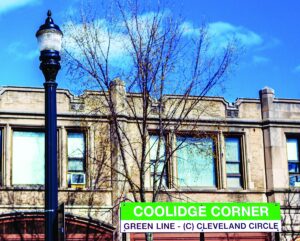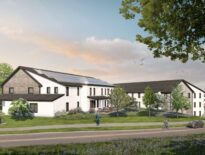State housing officials announced Thursday afternoon that they will let Boston-area towns and cities add a potentially controversial requirement for mixed-use buildings to zoning changes designed to comply with the MBTA Communities transit-oriented zoning law.
An announcement, Secretary of Housing and Livable Communities Ed Augustus said that up to 25 percent of the units a town must zone for can be located in zoning districts, restricted to existing village centers and downtowns, that require ground-floor retail or other uses while still allowing upper-floor residential units.
“The MBTA Communities law is a vital tool to incentivize and expedite much-needed housing development across the state,” Augustus said in a statement emailed to reporters. “These updated guidelines demonstrate a collaborative effort with MBTA Communities to implement the law, ensure compliance, and provide reasonable adjustments to zoning requirements without reducing the total number of required housing units. Nevertheless, compliance with the law is mandatory and today’s updates specify thirteen additional discretionary grant programs that will now take 3A non-compliance into consideration when awarding funds.”
‘Carrot and Stick’
The changes announced Thursday also add a laundry list of new state grant programs to the list that towns and cities would lose access to if they failed to comply, from community planning grants and climate change-preparedness grants to funds for brownfields restoration and rural development. While some municipalities, like Lexington, have been eager to rewrite their zoning to allow for more development many have not. One, the Worcester suburb of Holden, has flat-out refused to comply and in the process drawn a civil rights lawsuit accusing it of excluding minorities.
Greater Boston Chamber of Commerce President and CEO Jim Rooney gave the twin changes a vote of confidence.
“The key to solving our housing crisis is to focus on supply and new construction. We urgently need more units. Our lack of housing production in Massachusetts only contributes to continued increases in housing costs, which is a serious competitive disadvantage,” he said in an emailed statement. The changes “demonstrate that the Healey-Driscoll administration continues to prioritize solving the housing crisis while listening and collaborating with the Commonwealth’s municipal leaders.”
The Healey administration’s moves come as Brookline Town Meeting members gear up to consider a package of zoning along the community’s busy Harvard Street commercial corridor this fall. The changes are intended to comply with the MBTA Communities law, and while state officials did carve out space for towns and cities offer density bonuses to encourage developers to include ground-floor retail, the law’s original regulations specifically prohibited ground-floor retail requirements out of fear they would get used to poison development proposals with economically infeasible requirements, like retail space in an out-of-the-way office park. That requirement has become a serious point of contention between Brookline residents who support the zoning changes and those who fear giving up the ability to require ground-floor retail will deal killer blows to the retail districts that help give neighborhoods their identities.
Leading Real Estate Figure Cautious
Reaction from real estate and housing groups was mixed. In an email, developer trade group NAIOP-MA CEO Tamara Small told Banker & Tradesman that her organization would “continue to monitor the program’s implementation to ensure that the goal of the law, housing production, is achieved” while noting that the state permitted housing at half the national rate last year and increasing that rate was “critical.”
Rachel Heller, executive director of housing advocacy group CHAPA, said she believed the new guidelines could needlessly increase construction costs and either rents or sale prices for units in these mixed-use districts.
“It is more expensive to build and operate mixed-use buildings, and often the housing will subsidize the commercial space,” she said. “The original guidelines already allowed incentives like allowing for more height and more homes that can help pay for commercial space on the ground floor.”
And, she warned, if towns and cities don’t think more broadly about how other barriers to retail success, like convoluted sign permitting or zoning that bars certain types of retail businesses, plenty of barriers to development will still be in place.
“Requiring commercial space, in many of these areas, is another barrier,” she said. “I do hope that [towns and cities] will look at these village centers and put together a package of incentives, like density bonuses, that get them [the walkable business districts] they want. You could have taller buildings in this mixed-use area, and triple-deckers further out. There’s tremendous flexibility in these regulations.”
Heller called for the state to exercise rigorous oversight of towns’ and cities’ proposed mixed-use districts, which must be approved by Augustus’ office before being voted on by a town meeting or city council, including making these municipalities prove the mixed-use district is financially feasible and won’t be an obstacle to housing production. A similar burden is already placed on towns and cities that want to increase the affordable housing requirement in their MBTA Communities above 10 percent.
Reasons for Optimism Seen
Greg Vasil, CEO of the Greater Boston Real Estate Board, was more sanguine, saying Healey administration officials “wouldn’t have proposed this change if they didn’t think it was going to make a difference.”
And Jesse Kanson-Benanav, executive director of housing advocacy group Abundant Homes-MA, said the firm limits placed on where mixed-use districts could be and the cap on how much of a town’s required housing capacity could be included would likely prevent the changes from scuppering the MBTA Communities law’s objectives.
“We need units, and that’s [the Healey administration’s] number-one concern, so if there’s a way to work with communities to get this done faster, let’s do it,” Vasil said, explaining that he hopes this change could short-circuit at least a portion of opposition to the MBTA Communities law from voters and municipal officials in urban and suburban areas. “If a community is on board, that community can also be creative.”
The stakes are high. Brookline’s rezoning proposal could add capacity for developers to build 800 new units in the town as-of-right, meaning they would not have to go through the kinds of drawn-out permitting and rezoning processes that add cost and uncertainty – hurdles that towns and cities have successfully used to block many developments in the past. And, in Newton, the city’s most recent proposal could generate thousands of new homes in its 12 village districts that have only seen limited multifamily development so far.
Curbs on Mixed-Use Requirements
While towns and cities will now be able to create mixed-use zoning districts and count the units thus permitted by-right towards the total number of multifamily units they have to zone for, they face curbs that the administration argues will preserve the financial viability of projects proposed in MBTA Communities zones. The mixed-use zone must be in an existing commercial node or downtown, must have at least three homes per lot and can’t require a special permit process to receive a building permit. No age restrictions, occupancy or unit-size requirements can be applied to units in the zone. Any requirement for ground-floor, non-residential use can’t cover more than 33 percent of a building’s floor or lot area.
Furthermore, no minimum parking requirements can be included. Thanks to the cost of digging out basement garages or trading out developable land for surface parking, developers and researchers say parking minimums around the Boston area routinely scupper housing developments and drive up costs for those that get built.
Greg Reibman, executive director of the Charles River Regional Chamber covering Newton, Needham and several adjacent communities, said the move to allow ground-floor retail requirements, but set hard limits around those, represented a smart compromise and headed off any potential legislation from Beacon Hill that could add months or years of uncertainty given the state legislature’s slow pace.
“We urgently need housing but I was worried the way MBTA Communities guidelines were set up we could lose mom-and-pop small businesses” as single-story retail properties got redeveloped, he said. “The Newton City Council is working on a plan right now, this will make those discussions easier for counselors who are on the fence.”
Communities outside of Boston served by the MBTA subway network – Braintree, Brookline, Cambridge, Chelsea, Everett, Malden, Medford, Milton, Newton, Quincy, Somerville and Revere – must have their MBTA Communities-compliant zoning in place by Dec. 31, while communities that host commuter rail stops and others with bus service or which are near an MBTA commuter rail stop must have adopted their new zoning by Dec. 31, 2024. Small towns at the fringes of the MBTA network have until Dec. 31, 2025.
This story has been updated with comment from CHAPA and Abundant Homes-MA.







